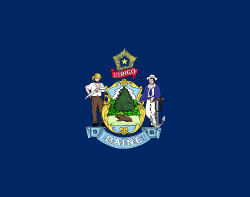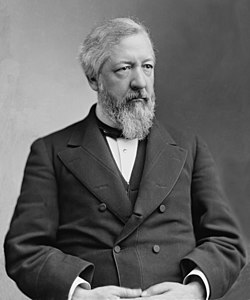Portal:Maine
The Maine Portal

Maine (/meɪn/ ⓘ MAYN) is a state in the New England region of the United States, and the northeasternmost state in the Contiguous United States. It borders New Hampshire to the west, the Gulf of Maine to the southeast, and the Canadian provinces of New Brunswick and Quebec to the northeast and northwest, and shares a maritime border with Nova Scotia. Maine is the largest state in New England by total area, nearly larger than the combined area of the remaining five states. Of the 50 U.S. states, it is the 12th-smallest by area, the 9th-least populous, the 13th-least densely populated, and the most rural. Maine's capital is Augusta, and its most populous city is Portland, with a total population of 68,408, as of the 2020 census.
The territory of Maine has been inhabited by Indigenous populations for about 12,000 years, after the glaciers retreated during the last ice age. At the time of European arrival, several Algonquian-speaking nations governed the area and these nations are now known as the Wabanaki Confederacy. The first European settlement in the area was by the French in 1604 on Saint Croix Island, founded by Pierre Dugua, Sieur de Mons. The first English settlement was the short-lived Popham Colony, established by the Plymouth Company in 1607. A number of English settlements were established along the coast of Maine in the 1620s, although the rugged climate and conflict with the local Indigenous people caused many to fail. As Maine entered the 18th century, only a half dozen European settlements had survived. Loyalist and Patriot forces contended for Maine's territory during the American Revolution. During the War of 1812, the largely undefended eastern region of Maine was occupied by British forces with the goal of annexing it to Canada via the Colony of New Ireland, but returned to the United States following failed British offensives on the northern border, mid-Atlantic and south which produced a peace treaty that restored the pre-war boundaries. Maine was part of the Commonwealth of Massachusetts until 1820 when it voted to secede from Massachusetts to become a separate state. On March 15, 1820, under the Missouri Compromise, Maine was admitted to the Union as the 23rd state.
Today, Maine is known for its jagged, rocky Atlantic Ocean and bay-shore coastlines, mountains, heavily forested interior, and its cuisine, particularly wild lowbush blueberries and seafood such as lobster and clams. Coastal and Down East Maine have emerged as important centers for the creative economy, especially in the vicinity of Portland, which has also brought gentrification to the city and its metropolitan area. (Full article...)
Selected article -

Bates College (/beɪts/) is a private liberal arts college in Lewiston, Maine. Anchored by the Historic Quad, the campus of Bates totals 813 acres (329 ha) with a small urban campus which includes 33 Victorian Houses as some of the dormitories. It maintains 600 acres (240 ha) of nature preserve known as the "Bates-Morse Mountain" near Campbell Island and a coastal center on Atkins Bay. With an annual enrollment of approximately 1,800 students, it is the smallest college in its athletic conference.
The college was founded in 1855, by abolitionist statesman Oren Burbank Cheney and textile tycoon Benjamin Bates. It became the first coeducational college in New England and the third-oldest college in Maine, after Bowdoin and Colby College. Bates provides undergraduate instruction in the humanities, social sciences, natural sciences, and engineering. The undergraduate program requires a thesis upon graduation and maintains a privately funded research enterprise. In addition to being a part of the "Maine Big Three", Bates competes in the New England Small College Athletic Conference (NESCAC) with 31 varsity teams, and 9 club teams. (Full article...)
New articles
Rules | Match log | Results page (for watching) | Last updated: 2025-06-22 21:39 (UTC)
Note: The list display can now be customized by each user. See List display personalization for details.
- Malachi F. Anderson (edit | talk | history | links | watch | logs | tools) by MoviesandTelevisionFan (talk · contribs · new pages (20)) started on 2025-06-22, score: 34
- Maine Footy (edit | talk | history | links | watch | logs | tools) by MAINEiac4434 (talk · contribs · new pages (2)) started on 2025-06-17, score: 44
- 2024 Portland, Maine flood (edit | talk | history | links | watch | logs | tools) by Namiba (talk · contribs · new pages (194)) started on 2025-06-16, score: 44
- Doug Gilding (edit | talk | history | links | watch | logs | tools) by InspiredByGeorgetownPJI (talk · contribs · new pages (2)) started on 2025-06-15, score: 22
- House of Maillé (edit | talk | history | links | watch | logs | tools) by 3PPYB6 (talk · contribs · new pages (9)) started on 2025-06-14, score: 30
- Oisin Curran (edit | talk | history | links | watch | logs | tools) by MediaKyle (talk · contribs · new pages (32)) started on 2025-06-11, score: 23
- Sunflower Farm (edit | talk | history | links | watch | logs | tools) by Seasider53 (talk · contribs · new pages (12)) started on 2025-06-11, score: 34
- METRO Pulse (bus station) (edit | talk | history | links | watch | logs | tools) by Seasider53 (talk · contribs · new pages (12)) started on 2025-06-08, score: 44
|
Images -
Did you know -
- ... that a Maine TV station was so protective of its evening newscast that it preempted nearly 40 percent of all NBC Sports programming in 1994?
- ... that John Bunker was inspired to propagate old apple tree varieties after encountering Black Oxford apples while managing the food co-op in Belfast, Maine?
- ... that the Frank J. Wood Bridge is the seventh bridge built across the Androscoggin River to link the towns of Brunswick and Topsham, Maine, since 1796?
- ... that the August 2014 United States floods set rainfall records across cities in several states, including Michigan, Maine, and New York?
- ... that there is a "desert" in Maine?
- ... that journalist Jacques Poitras spent a month repeatedly crossing the "Imaginary Line" separating New Brunswick and Maine in order to publish a book about it?
Topics
Largest cities
The list below, for each city, shows the population in 2010, the population estimate of 2019, the growth/shrinking percentage between the three, and the date of incorporation as a city.
| 2019 Rank | City | 2019 Estimate | 2010 Census | Change | County | Incorporation (town) [citation needed] |
Incorporation (city) [citation needed] |
Land area (sq mi) |
|---|---|---|---|---|---|---|---|---|
| 1 | Portland † | 66,215 | 66,194 | +0.03% | Cumberland | 1786 | 1833 | 69.4 |
| 2 | Lewiston | 36,225 | 36,592 | −1.00% | Androscoggin | 1795 | 1862 | 34.2 |
| 3 | Bangor † | 32,262 | 33,039 | −2.35% | Penobscot | 1791 | 1834 | 34.3 |
| 4 | South Portland | 25,532 | 25,002 | +2.12% | Cumberland | 1895 | 1898 | 12.1 |
| 5 | Auburn † | 23,414 | 23,055 | +1.56% | Androscoggin | 1842 | 1868 | 59.3 |
| 6 | Biddeford | 21,504 | 21,277 | +1.07% | York | 1653 | 1855 | 30.1 |
| 7 | Sanford | 21,223 | 20,798 | +2.04% | York | 1768 | 2013 | 47.8 |
| 8 | Saco | 19,964 | 18,482 | +8.02% | York | 1775 | 1867 | 38.6 |
| 9 | Westbrook | 19,074 | 17,494 | +9.03% | Cumberland | 1814 | 1891 | 17.2 |
| 10 | Augusta †† | 18,697 | 19,136 | −2.29% | Kennebec | 1797 | 1849 | 55.2 |
† County seat
†† State capital and county seat
Categories
Related portals
WikiProjects
Associated Wikimedia
The following Wikimedia Foundation sister projects provide more on this subject:
-
Commons
Free media repository -
Wikibooks
Free textbooks and manuals -
Wikidata
Free knowledge base -
Wikinews
Free-content news -
Wikiquote
Collection of quotations -
Wikisource
Free-content library -
Wikiversity
Free learning tools -
Wikivoyage
Free travel guide -
Wiktionary
Dictionary and thesaurus
Sources
|}























































